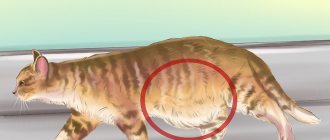Rarely does a modern family survive without a pet. Dogs and cats have long become an integral part of existence for many people. However, we should not forget that pets are carriers and carriers of many parasitic infections. And in this sense, they cause irreparable harm to their owners.
Cats are especially dangerous because they carry a dangerous infection - toxoplasmosis, which affects children and pregnant women. Naturally, any sane person has a question: is it possible to become infected with worms from a cat? After all, most often pets live in families where children are raised. Are they a serious threat to their health? Next we will try to answer these and other questions.
What worms parasitize cats?
Unfortunately, the number of worms parasitizing a cat’s body can be extended into a long list.
Here are their main types:
- Nematodes or roundworms. This type of parasite is localized in the cat's intestines. The most dangerous species are cat toxocara, hookworm and roundworm. Toxocara causes the disease toxocorosis, which is usually asymptomatic, but massive infestations of this parasite can lead to the death of the animal. Hookworm enters the cat's body through the soil, during the animal's walks and games on the street.
- Cestodes or tapeworms. Representatives of this class of worms have a flat, ribbon-shaped body, which is reflected in their name. They penetrate the intestinal mucosa with their head, which is capable of detaching from the body and expelling a large number of eggs. This class of helminths includes the broad tapeworm, cucumber tapeworm and other types of tapeworms.
- Trematodes or flatworms (flukes). This type of worm can parasitize not only the intestines, but also other organs of the cat. This class of worms includes the cat fluke, which can seriously damage the liver of an animal.
However, the listed types of helminths are not transmitted to humans from cats. This can be explained by the fact that many parasites need an intermediate host, since without it their life cycle is disrupted and they will not be able to develop into an adult. For this reason, helminths are not transmitted directly from cats to humans. A person, of course, can become infected with these parasites, but not from a cat.
Infection with worms in a cat is dangerous for another reason. During the development of a parasitic infection, animals become aggressive and uncontrollable. They can rush at their owners, scratch and bite. Therefore, at the first signs of inappropriate cat behavior, you should immediately take the animal to the veterinarian.
The first symptoms of helminthiasis in humans
Manifestations of helminthiasis in humans depend on the type of cat worms parasitizing in his body.
Toxocariasis manifests itself:
- allergic reactions (a general blood test shows a high level of eosinophils);
- difficulty breathing (due to bronchospasm, pneumonia, pleura);
- decreased visual acuity, purulent inflammation of the mucous membrane and inner membranes of the eye;
- in case of damage to the central nervous system - epileptoid-like seizures.
Hookworm infection can be suspected in a person based on the following signs:
- decreased performance;
- fast fatiguability;
- anemia;
- bowel dysfunction.
Cucumber tapeworm causes excessive salivation, attacks of nausea, abdominal pain, itching in the anus, sleep disturbances, and anemia.
Symptoms of echinococcosis may not appear in a person for many years.
When infestation with echinococci worsens, the manifestations depend on the location of the parasite:
- brain - pain, vomiting, dizziness, increased intracranial pressure, epileptic seizures, delirium, depression, dementia, paralysis;
- gallbladder and ducts - hepatic colic, attacks of nausea, vomiting, jaundice, colorless stools, increased body temperature;
- lungs – dry cough, later with sputum or blood, shortness of breath;
- kidneys - loss of appetite, general weakness, weight loss, itching of the skin, pain in the hypochondrium or lumbar region, renal colic, fever, blood in the urine, urinary retention;
- heart - myocardial infarction, rhythm disturbance, blockage of the pulmonary arteries with hemoptysis, pain, fever;
- spinal cord – pain in the legs, arms, chest, paralysis of the limbs, dysfunction of the pelvic organs, curvature of the spine.
Giardiasis often does not manifest itself at all. Symptoms of a pathological condition caused by Giardia are pain in the right side under the ribs, around the navel, in the pit of the stomach. The temperature rises, appetite disappears. A person is also tormented by other manifestations:
- headache;
- nausea, vomiting;
- flatulence, diarrhea;
- fatigue, sudden mood changes;
- dermatitis, allergic rhinitis, conjunctivitis;
- joint inflammation.
A person can live with Toxoplasma for many years and not even know about the presence of the parasite. The acute stage of infection is manifested by symptoms similar to the flu. In people with weak immune systems, toxoplasmosis can cause encephalitis.
Toxoplasma is most dangerous for pregnant women. The parasite penetrates the placental barrier and infects the fetus. As a result, a miscarriage occurs or severe defects are formed.
Ways of infection of cats
Cats have their own ways of becoming infected with helminths:
- from small rodents (mice and rats) that they eat;
- through fleas and flies;
- when consuming raw meat and fish contaminated with helminth eggs;
- when walking outside, a cat can pick up helminth eggs, since they are found everywhere: in the grass, in the soil, in the water;
- in contact with other cats;
- small kittens become infected through mother's milk if an adult cat is infected, however, it is more difficult for kittens to tolerate a helminthic infection than for adult cats;
- if the cat drinks water from a puddle;
- when licking your fur;
- through your feces.
Treatment of helminthic infestation
All helminthiases are harmful to health. Even when there are no obvious symptoms, parasites poison the body, cause allergies, reduce immunity, and, according to many doctors, shorten life expectancy.
At the first suspicion of helminthic infestation in a person, you need to go to the clinic, get tested and undergo an examination. After examination by a veterinarian, the pet is given a complex remedy. People are prescribed:
- a targeted drug that kills worms of a certain type;
- antihistamines to suppress an allergic reaction;
- sorbents to eliminate intoxication during mass death of parasites.
Echinococcosis requires surgical intervention - the cysts are removed, sometimes with a fragment of the affected organ. For alveococcosis, chemotherapy with anthelmintic drugs and removal of nodes are indicated. Toxocariasis is treated with courses until complete recovery.
What parasites can you get from a cat?
However, all of the above does not mean that a cat living at home cannot become a source of infection for humans. The domestic cat is a carrier of protozoan parasites that cause serious diseases in the human body:
- Giardia, which causes giardiasis;
- toxoplasma, which causes toxoplasmosis.
But this list can be continued with representatives of round and tapeworms that are transmitted to humans from cats:
- roundworm (roundworm);
- toxocara (roundworm);
- pinworms (roundworm);
- Echinococcus (tapeworm).
It may seem surprising that this list includes pinworms, which are exclusively “humane” parasites. The thing is that pinworms have an amazing rate of maturation of eggs, which are easily dispersed in the environment and settle on toys, linen, clothes, household items and the soft fur of a beloved pet. Consequently, a person becomes infected with pinworms not from cats, but because they are everywhere around us.
Leading a free lifestyle, cats can bring eggs of any parasite into the house, and humans can swallow them. But it’s worth remembering that the human body is not suitable as the primary host for all parasites.
Allergic reactions of humans to cats
This is one of the most common problems and reasons for not keeping animals at home. Most often, allergic reactions occur to the fur and epidermis (the upper, exfoliating layer of skin) of pets.
If an allergy occurs during pregnancy to the fur or epidermis of a pet, the optimal solution to the problem is to reduce the duration of contact between the pregnant woman and the animal. It is better to give the dog or cat to one of your relatives or friends for a while. In case of severe allergic reactions, this measure is mandatory.
If this option is not possible, you should consult your doctor about antihistamines (anti-allergic) drugs allowed during pregnancy and start taking them. The allergic reaction itself in the expectant mother does not cause allergies in the baby (immune complexes do not penetrate the placenta).
Allergies can manifest as congestion, swelling of the nasopharynx, face, lacrimation, skin rashes, itching, and in severe cases, difficulty breathing, even asthmatic suffocation.
However, changes in the condition of the pregnant woman, deterioration of the uteroplacental circulation during antiallergic treatment, and the adverse effect of antihistamines on the fetus can complicate the course of pregnancy due to allergies.
Due to the fact that by the 22nd week of pregnancy the fetal immune system reaches some maturity, from this period the intake of highly allergenic substances into the mother’s body and contacts with them should be limited. The fact is that after birth, due to the baby’s increased sensitivity, these allergens can cause severe allergic reactions.
How can you get worms from a cat?
Helminths are transmitted from cats to humans in the following ways:
- in direct contact with a pet;
- in case of non-compliance with personal hygiene rules;
- through cat feces;
- through cat saliva.
Having a cat in the house, of course, increases the chances of family members becoming infected with helminths. Because the routes of transmission of parasitic infection are very simple. Despite the fact that a cat is a very clean animal, constant licking of its fur only increases the likelihood of infection with parasites, since helminth eggs are distributed throughout the hair. In this case, the cat's tongue is the most dangerous spreader of infection. To do this, you just need to pet the cat and not wash your hands - and infection with worms is guaranteed.
A colossal accumulation of eggs is cat litter. Since female worms secrete hundreds of thousands of eggs every day, they are ejected into the external environment along with feces. Even regular and thorough cleaning of the cat's litter box does not completely avoid infection. In addition, helminth eggs accumulate in large quantities in the cat's litter box, and smooth, microscopic helminth eggs easily spread everywhere. Therefore, it is necessary to clean the cat litter exclusively with gloves, since the larvae of roundworms can even pass through the skin. The tray itself and the area around it should be regularly treated with a disinfectant.
Avoiding infection is simple, but at the same time difficult. Even hand washing does not always save us from infection, because our beloved pet licks our hands, rubs us on our clothes, touches us with its paws and nose, and sleeps in its owner’s bed.
For this purpose, it is much more reliable to carry out preventive measures. It is a very erroneous opinion that a cat that does not go outside and onto the landing does not have helminths.
Features of getting rid of parasites transmitted from a pet
If you find out that worms were transmitted from a cat, treatment must be carried out simultaneously in both the person and the cat. The ideal option is to consult a doctor who will conduct an examination of you and your pet; ridding the body of worms and parasites should be done exclusively by a specialist. There are often cases when a stool test does not show the presence of worms, but the state of health is in doubt and therefore the doctor decides to additionally check for worms; worms can be detected by testing for antibodies to parasites.
Additionally, but subject to consultation with a doctor, you can purchase anthelmintic medications, which are constantly being improved, thanks to which a person can easily get rid of worms. Pirantel is suitable for you and your family members, but for your pet you need to purchase Azinox; you need to take the drugs on the same day, preferably even at the same time.
The repeated procedure for taking medications should be repeated after two weeks; as a rule, 10-14 days are necessary for the development of new parasites, provided that the treatment was not completed or new larvae entered the body again.
Remember that in most cases, worms are transmitted from cats to humans, and therefore all pet owners are advised to observe personal hygiene measures, regularly disinfect the pet's tray, and somewhat limit it, prohibiting it from climbing onto the dining table and other most common places. To prevent a person from becoming infected with worms from a cat, if there is even the slightest suspicion of the presence of helminths, it is necessary to immediately contact both a veterinarian and a parasitologist.
What diseases do cat parasites cause in humans?
Helminths that parasitize a cat’s body cause the following diseases in humans:
- ascariasis;
- toxocariasis;
- giardiasis;
- toxoplasmosis;
- echinococcosis.
Ascariasis
A cat can become infected with roundworms without even leaving the house. Because a person himself brings in helminth eggs from the street on his shoes, and cats meet their owner and rub against his feet. Thus, roundworm eggs fall on the paws and fur of animals, and are then swallowed by them. Cat feces contaminated with roundworms are the main source of infection.
Roundworms, once in the human body, cause serious pathological processes. In the larval stage, they are able to migrate throughout the body, causing general intoxication of the body. Only once they enter the small intestine do adult individuals become localized there. An infected person experiences serious symptoms during the larval migration period:
- stomach ache;
- nausea and vomiting;
- lack of appetite;
- upset stomach: constipation gives way to diarrhea;
- unexplained weight loss;
- intoxication of the body;
- allergic reactions;
- decreased immunity.
Toxocariasis
Infection of a cat with Toxocara cati parasites occurs when the cat walks outside, since Toxocara cati eggs are in the soil and mixed with dust. The eggs fall on the cat's paws and fur, and then, while licking itself, the animal swallows them. A cat that is always at home can also become infected with helminths, since street dust enters the living space through open windows or is carried into the house with shoes.
The second way a cat can become infected is by eating raw meat and fish infected with Toxocara. After all, parasite larvae are often found in raw meat, which owners feed to their pets. Cats that eat infected rodents (mice and rats) can also become infected in this way.
Once in the human body, Toxocara affects the central nervous system, causing allergic reactions and damage to the optic nerves. In an infected person, symptoms are observed only at the second stage of the disease, when the larvae begin to migrate. During this period the following symptoms appear:
- low-grade fever (up to 37.5);
- general malaise, weakness and fatigue;
- stomach ache;
- nausea and vomiting;
- diarrhea;
- skin rash;
- liver enlargement;
- enlarged lymph nodes.
Giardiasis
Giardia is not a worm, a bacterium, or a virus. This is the simplest single-celled microorganism, one of the most common parasites in cats, dogs, rodents and humans.
Cats become infected with Giardia through contaminated water and food. A cat, washing itself after visiting the toilet, swallows Giardia cysts (larvae). When enough Giardia accumulates, she develops symptoms of a parasitic infection.
From an infected cat, Giardia gets to a person, and he experiences the following symptoms:
- pain in the epigastric region, in the navel area;
- nausea;
- flatulence;
- constipation and diarrhea;
- yellow stool with mucus.
Toxoplasmosis
Toxoplasmosis is a fairly common disease in domestic cats. A cat can swallow the parasite while walking, eating infected foods, or licking its paws after using the toilet. Toxoplasma is very common in the environment. They are found almost everywhere. A person can become infected from a cat by removing its tray with feces, and not always, but only in cases where the feces have been in the tray for more than a day. Because the cysts must mature.
The symptoms of toxoplasmosis in humans are characterized by their diversity, so the disease can only be identified using serological blood tests. With strong immunity, the disease is completely asymptomatic. Infection of a pregnant woman with toxoplasma poses a serious danger, since the parasite affects the fetus, causing serious damage to its organs and systems, as well as to persons with reduced immunity (HIV infection).
Echinococcosis
Domestic cats are infected with echinococcosis through the fecal-oral route. Cats are the main host for Echinococcus. The parasite comes to them from small rodents (mice, shrews). The maturation of adult individuals occurs in the intestines of a cat, but the stage of maturation of larvae occurs in intermediate hosts (small and cattle, horses, pigs, humans). Cases when a cat becomes an intermediate host are quite rare, but they do exist. This occurs when a cat swallows Echinococcus eggs. If the eggs of this parasite enter the human body, then it also becomes an intermediate host. And in this case, the parasite lives a long, happy life of 20 years.
Echinococcus causes serious damage to a person's liver, heart, brain or any other organ in which its larvae have settled. The course of echinococcosis is so complex that it can lead to death of the patient. Symptoms of the disease depend on which organ is affected by the parasite.
Symptoms of parasitic infestation
To prevent infection with helminths, the owner needs to monitor the health of his pet, regularly take him for examinations to a veterinary clinic, and in between, examine him himself. Absolutely all parasitic organisms do not have the goal of killing their host, because if he dies, they will have nowhere to live. But the constant lack of nutrients, the lion's share of which goes to feed the parasites, as well as the toxins released by them in the process of life, significantly weaken the body of the helminth carrier. And the symptoms of helminthic infestation are always present; a person only needs to carefully monitor the behavior and condition of his pet.
The first sign that a cat has worms is a change in appetite. The cat may refuse to eat or, conversely, constantly ask for food; it may develop unusual cravings. At the same time, the pet becomes lethargic, apathetic, and can lie for days on end, only getting up to go to the bowl.
Also symptoms of helminthic infestation are:
- digestive disorders (alternating constipation and diarrhea or one of these manifestations on an ongoing basis);
- dyspeptic symptoms;
- cough;
- discharge from the eyes;
- the appearance of allergic reactions;
- constant licking of the perineal area due to itching of the anus;
- the presence in the excrement of various impurities (blood, mucus), as well as worms visible to the eye.
If helminths have infected a kitten’s body, it may experience delayed growth and development and slow weight gain. In an adult animal, the condition of the coat deteriorates; in severe cases, convulsions and loss of coordination of movements may occur.
Your pet may complain by meowing loudly if the presence of worms causes pain or discomfort in the abdomen.
When helminths begin to actively grow and multiply, a lump of worms in the intestines causes tension and swelling of the abdomen, and an increase in its size.
If you observe such symptoms, you should immediately contact your veterinarian. He will examine the animal, determine the type of helminthic infestation and prescribe the most effective medications. A sick cat can infect both other pets and people. Therefore, measures should be taken immediately, especially if there are children in the house.
How to avoid getting worms from a cat
In order not to become infected with helminths from a cat, you should follow a number of simple rules:
- first of all, always wash your hands after every contact with a domestic cat and especially after touching stray animals;
- Be sure to wash your hands before eating and after using the toilet;
- From an early age, children should be taught personal hygiene;
- The cat should not be allowed to sleep in the same bed with children and adults;
- don't kiss the cat;
- You should clean the cat's litter box in a timely manner and do it with rubber gloves, since nematodes can penetrate the skin;
- it is advisable not to let your domestic cat outside, since it will not be able to avoid contact with other animals, contaminated soil, water and soil;
- Do not accustom your domestic cat to raw meat and fish; they must be subjected to high-quality heat treatment; do not lightly cook the meat, in this case the parasites will not die;
- It is strongly recommended to carry out regular deworming of pets with special anthelmintic drugs;
- Carry out regular preventive examinations of your cat at the veterinarian;
- treat cat bowls and litter tray with disinfectant;
- Children should not be allowed to touch stray animals, since they are the source of parasitic infection.
Unwashed Hands Disease
Theoretically, helminth eggs can get onto human hands not only from a cat.
Staying in public places and gardening without gloves also poses a risk of infection.
Hygiene will help you avoid trouble.
Washing your hands after visiting the toilet, public transport, and before eating will prevent infections and parasite eggs from entering the oral cavity.
Infection from cats
A pet can be a source of infections. After contact with a cat, you should always wash your hands, especially before eating. This rule also applies to animals that have undergone deworming.
What can be the risk of infection with worms?
It is worth considering that infection with this type of worms is a serious disease and can lead to unpleasant consequences and long-term treatment for both pets and humans.
The main danger is that human infection cannot always be determined immediately and not only cats, but also dogs can be carriers. In addition, these are parasitic organisms; they not only live by feeding on human or animal resources, but the results of their vital activity significantly pollute the organism in which they live.
Types of worms transmitted to humans
The cat’s body contains helminths, divided into two groups:
- Roundworms or nematodes. Long and thin, like pasta, their body length can be up to 80 cm. Of course, such long worms will not fit in the intestines of a cat, but up to 10 cm they will take root quite well. Nematodes are divided into 3 classes and 30 orders (according to the 2011 classification) and are causative agents of various diseases in cats and humans.
- Tapeworms or cestodes. They belong to the class of flat parasitic worms; about 4,000 species are currently described.
The following parasites pose a danger to humans:
- Wide tapeworm (cestodes);
- Cucumber tapeworm (cestodes);
- Toxocara, roundworms (nematodes).
Diseases caused by nematodes
Hookworms are parasites that are found in tropical and subtropical climates much more often than in ours.
They destroy the intestinal walls and prevent blood clotting. They enter the human body through the skin, causing itching, redness and burning. They parasitize the intestines of cats and humans. Adults can provoke the formation of ulcers in the intestines, leading to blood loss and intoxication of the body.
Toxocariasis is a disease that affects children from 1 to 4 years of age. A person can become infected with it by consuming food and water contaminated by sick animals. The most common form of toxocariasis is the intestinal one.
Dangerous diseases caused by cestodes
The most dangerous diseases (for people) include:
- Dipilidiosis, the causative agent of which is the cucumber tapeworm. The disease is characterized by allergies and impaired digestive functions.
- Taeniasis, although it belongs to the group of neglected diseases, according to WHO, should be mentioned. The occurrence of the disease is provoked by the presence of pork (bovine) tapeworm in the cat’s intestines. Once in the human body, taeniasis causes intestinal upset, provokes attacks of pancreatitis and the development of cholecystitis.
- Echinococcosis, the causative agent of which is the larval stage of echinococcus (cestodes). The danger of echinococcosis is that it is characterized by the formation of parasitic cysts in the heart, abdominal cavity, biliary tract, lungs, kidneys, liver (in 70% of cases of infection), spleen, brain, spinal cord. True, the last three types of infection are very rare (0.2-1% of the total mass).
- Dibothriocephalosis or diphyllobothriasis. The causative agent is a wide tapeworm, characterized by pathological phenomena in the digestive organs, circulatory and nervous systems.
The most common disease is dipylidia, which occurs in 70-80% of cats and their owners.











